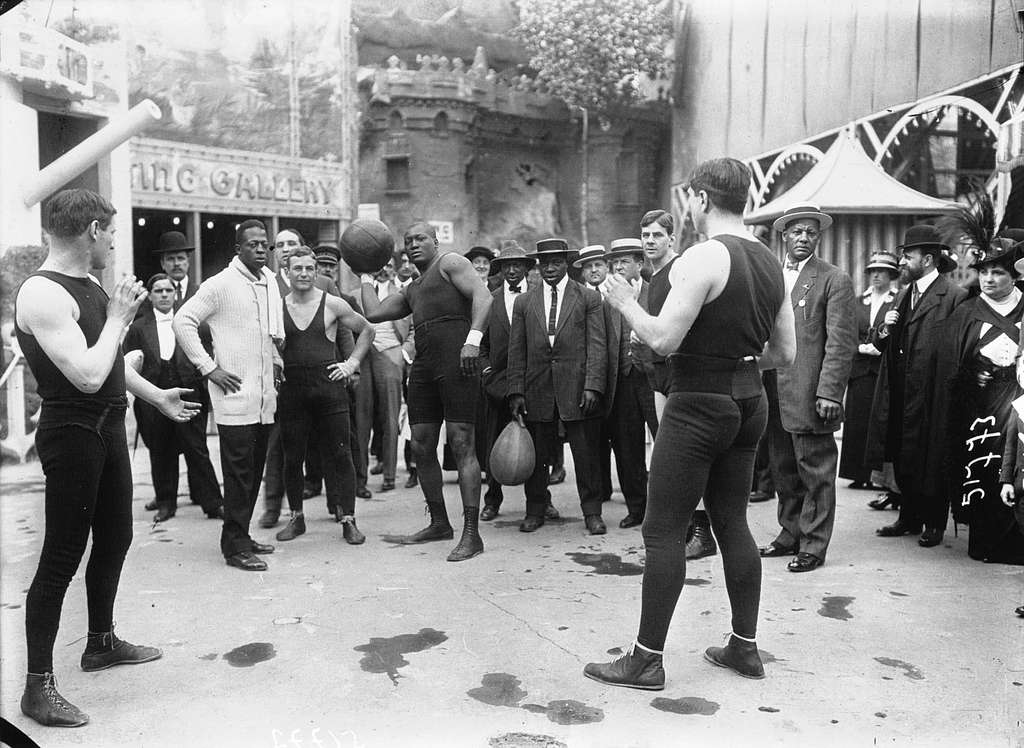The Galveston Giant Who Fought the World and Made History
In an era defined by segregation, racism, and violent enforcement of social norms, Jack Johnson did the unthinkable. He fought back — not just with his fists, but with his lifestyle, his intellect, and his unrelenting refusal to conform. As the first Black heavyweight boxing champion of the world, Johnson stood as a towering figure in both sports and civil rights history. His story is one of resistance, innovation, and enduring legacy.
📍 Early Life: Born Into a Divided America
Jack Arthur Johnson was born on March 31, 1878, in Galveston, Texas, to formerly enslaved parents. Growing up in the deeply segregated South, Johnson lived in a world where African Americans were legally and socially relegated to second-class citizenship. Yet from an early age, he demonstrated a remarkable independence of thought and a boldness that set him apart.
Working as a dock laborer and traveling entertainer, Johnson discovered boxing through informal “battle royales” — brutal contests where Black men were forced to fight blindfolded for the amusement of white spectators. But Johnson saw more than exploitation in the sport. He saw opportunity.
🥊 Rising Through the Ranks
Johnson turned professional in 1897, and over the next decade, he fought tirelessly — both in the ring and against systemic racism — to gain recognition. Despite his clear talent and technique, white boxing champions and promoters refused to let him challenge for the world title, citing the unspoken “color line” that kept Black fighters out of the sport’s highest ranks.
But Johnson’s skills were undeniable. He traveled the country and the world, taking on — and defeating — top white fighters in front of racially hostile crowds. His boxing style was unique: calm, strategic, and taunting. He didn’t just win — he dominated, often smiling and talking to his opponents mid-fight.
🏆 The 1908 Championship
On December 26, 1908, in Sydney, Australia, Jack Johnson finally got his chance. He faced Canadian champion Tommy Burns, a white fighter who had reluctantly agreed to the bout for a large payout. In front of 20,000 fans and under heavy security, Johnson dismantled Burns in a 14-round match. The police stopped the fight to avoid a complete humiliation, but it was too late — history had been made.
Jack Johnson was now the first Black heavyweight champion of the world. His victory was not just athletic — it was cultural and political. It directly challenged white supremacy and sent shockwaves through the United States.
⚔️ The Great White Hope and the Fight of the Century
In the wake of Johnson’s win, white America searched desperately for a fighter who could reclaim the title. The search gave rise to the term “The Great White Hope.” That hope materialized in Jim Jeffries, a former undefeated champion who had retired years earlier. Pressured into returning to the ring, Jeffries agreed to face Johnson.
On July 4, 1910, in Reno, Nevada, the two met in what was dubbed “The Fight of the Century.” It wasn’t just a boxing match — it was a symbolic battle over race, pride, and identity. Johnson dominated Jeffries, knocking him down twice before the fight was stopped in the 15th round.
The aftermath was brutal. Riots broke out across the U.S., with dozens of African Americans killed in the violence that followed. Johnson’s victory had proven that Black excellence could not be contained — and that frightened the white establishment.
💔 Legal Battles and the Mann Act
With public opinion against him, Johnson became a target. His open relationships with white women scandalized the nation, and in 1913, the U.S. government convicted him under the Mann Act, a law that prohibited transporting women across state lines for “immoral purposes.” The case was clearly racially motivated. Johnson was sentenced to a year and a day in prison.
Rather than serve time immediately, he fled the country and lived in exile for several years, continuing to box in Europe and South America. When he returned to the U.S. in 1920, he served his sentence.
🛠️ More Than a Boxer: Inventor and Cultural Icon
Jack Johnson wasn’t just a fighter. He was an inventor and a businessman. In 1922, he patented a wrench — U.S. Patent #1,413,121 — designed to tighten loosening fastening devices. It’s a reminder that his intelligence extended well beyond the ring.
He was also a fashion icon and early symbol of Black wealth and mobility. He drove flashy cars, wore custom suits, and refused to bow to the expectations of white society. His bold lifestyle inspired fear in his critics and admiration from many in the Black community, who saw him as a symbol of resistance and pride.
⚰️ Death and Posthumous Recognition
Jack Johnson died in 1946 in a car accident at the age of 68. At the time of his death, his legacy was still controversial — too radical, too proud, too Black for mainstream America to fully honor.
But over time, that changed. In 2005, the U.S. Congress passed a resolution urging a presidential pardon for his Mann Act conviction. Finally, on May 24, 2018, President Donald Trump granted a posthumous pardon to Jack Johnson — more than a century after the original injustice.
📚 Legacy That Lives On
Today, Jack Johnson’s legacy resonates far beyond boxing. He paved the way for later legends like Muhammad Ali, Joe Louis, and Mike Tyson, not just in the ring but in cultural and political impact.
He showed that a Black man could defy the odds, command respect, and demand dignity at a time when doing so risked everything. His life was a protest — against racism, against injustice, and against the idea that greatness had a color.
From Galveston to the global stage, Jack Johnson remains a towering figure in American history — an inventor, a champion, and a revolutionary spirit.
📸 Explore His Legacy
Want to see Jack Johnson’s journey come to life?
👉 [Visit the Gallery]
👉 [Download the Educator Toolkit]
👉 [Explore the Timeline]

